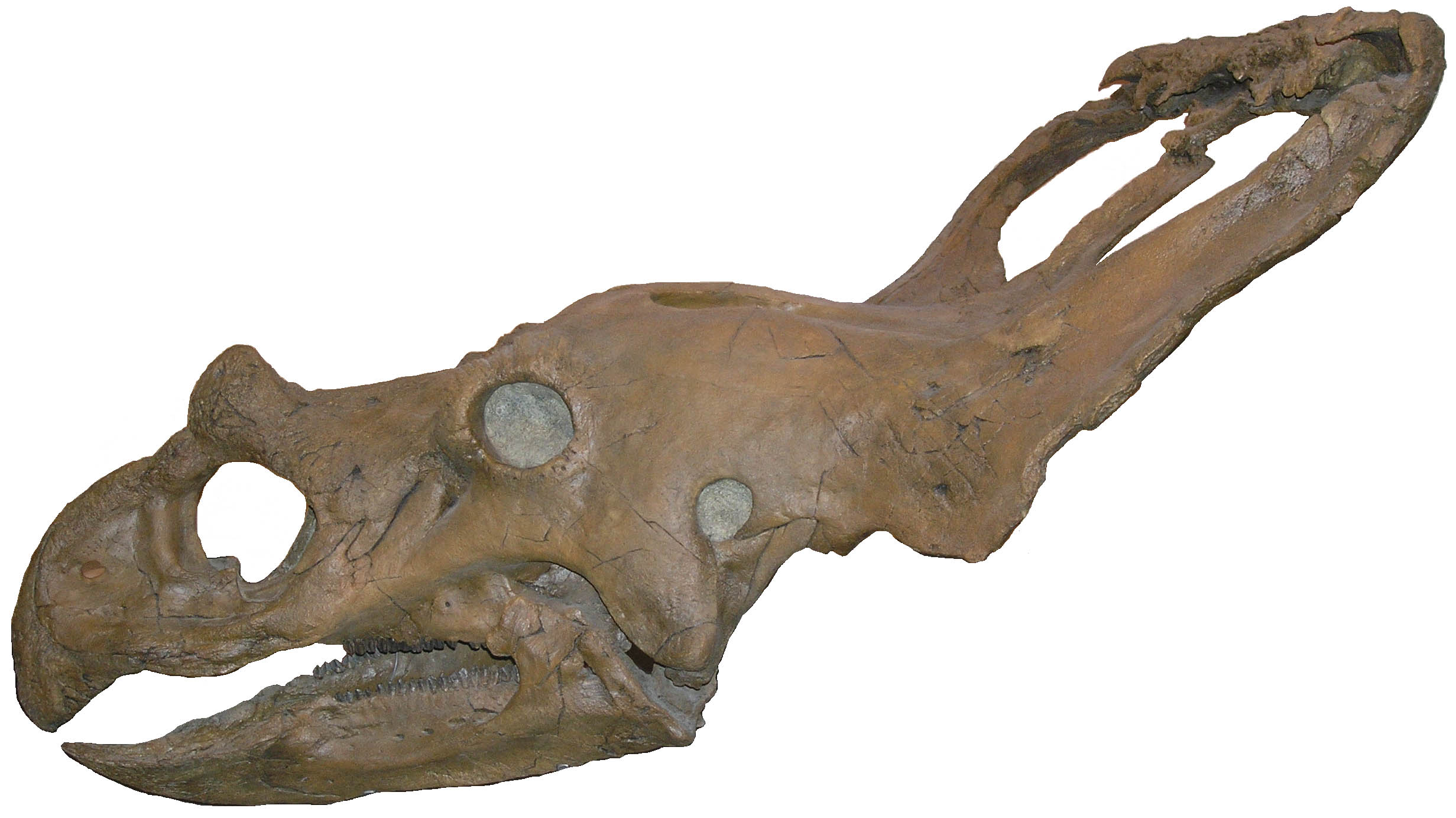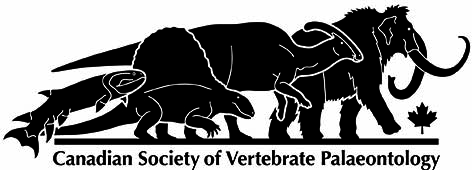The postcranial skeleton of Vagaceratops irvinensis (Dinosauria, Ceratopsidae)
DOI:
https://doi.org/10.18435/B5159VKeywords:
Ceratopsia, post-cranial, dinosaur, OrnithischiaAbstract
The postcranial skeleton of Vagaceratops (= Chasmosaurus) irvinensis (CMN 41357), lacking only the tail, most of the left front and left hind limbs, and portions of the pelvis, is preserved in articulation. It is one of the most complete, best articulated ceratopsid skeletons known. Both the manus and vertebral column exhibit conspicuous pathologies, possibly an indication of advanced age at the time of death. The vertebral column comprises a syncervical, six additional cervical vertebrae, and 12 dorsals. A partial synsacrum is represented by two dorsosacrals, four sacrals, two caudosacrals, and a partial third caudosacral centrum. The ribcage, although crushed, is nearly complete. The sternum is unusually wide compared with other ceratopsids. As in other chasmosaurines, the humerus bears a prominent deltopectoral crest that forms the anterior edge of the broad, rectangular proximal humeral expansion. The medial tuberosity is separated from the dorsal surface of the humerus by a distinct notch. The insertion for the latissimus dorsi is conspicuous. The deltopectoral crest extends a full half of the distance to the distal end of the humerus. Epipodials of the forelimb are relatively short compared to the corresponding propodial. The ulna has a long, distinctly triangular olecranon, broadly rounded anterolateral process, prominent medial process, and a deeply concave trochlear notch. The terminal phalanges on the fourth and fifth manual digits are relatively large, and unlike other ceratopsids have distinct distal ?articular facets. The fourth trochanter of the femur is relatively proximal in position. This study and other recent studies of ceratopsid postcrania suggest that potentially useful taxonomic variation is present in the number of dorsosacrals, size of the groove on the ventral surface of the sacrum, morphology of the last dorsal and dorsosacral ribs, morphology of the scapula and proximal expansion of the humerus, morphology of the ulna, ratio of humerus/epipodium, morphology of the fifth manual digit, and position of the fourth trochanter of the femur.Downloads
References
Adams, D. A. 1988. Structure and function of the ceratopsian forelimb, PhD dissertation, University of California, Berkeley, 379 pp.
Brown, B. 1906. New notes on the osteology of Triceratops. American Museum of Natural History Bulletin 22:297–301.
Brown, B. 1917. A complete skeleton of the horned dinosaur Monoclonius, and a description of a second skeleton showing skin impressions. Bulletin of the American Museum of Natural History 37:281–306.
Brown, B., and E. M. Schalikjer 1940. The structure and relationships of Protoceratops. Annals of the New York Academy of Sciences 40:133–266.
Campione, N., and R. Holmes. 2006. The anatomy and homologies of the ceratopsid syncervical. Journal of Vertebrate Paleontology 26:1014–1017.
Chinnery, B. 2004. Morphometric analysis of evolutionary trends in the ceratopsian postcranial skeleton. Journal of Vertebrate Paleontology 24:591–609.
Currie, P. J., W. Langston Jr., and D. H. Tanke. 2008. A new horned dinosaur from an Upper Cretaceous bone bed in Alberta. NRC Research Press, Ottawa, Ontario, Canada, 144 p.
Dodson, P., C. A. Forster, and S. D. Sampson. 2004. Ceratopsidae; pp. 494–513 in D. B. Weishampel, P. Dodson, and H. Osmólska (eds.), The Dinosauria, second edition, University of California Press, Berkeley, California.
Fujiwara, S-I. 2009. A reevaluation of the manus structure in Triceratops (Ceratopsia: Ceratopsidae). Journal of Vertebrate Paleontology 29:1136–1147.
Gilmore, C. W. 1917. Brachyceratops, a ceratopsian dinosaur from the Two Medicine Formation of Montana. United States Geological Survey Professional Paper 103:1–45.
Holmes, R. B, and C. Organ. 2007. An ossified tendon trellis in Chasmosaurus (Ornithischia: Ceratopsidae). Journal of Paleontology 81:411–414.
Holmes, R. B., C. Forster, M. Ryan, and K. M. Shepherd. 2001. A new species of Chasmosaurus (Dinosauria: Ceratopsia) from the Dinosaur Park Formation of southern Alberta. Canadian Journal of Earth Sciences 38:1423–1438.
Holmes, R., M. J. Ryan, and A. M. Murray. 2005. Photographic atlas of the postcranial skeleton of the type specimen of Styracosaurus albertensis with additional isolated cranial elements from Alberta. Syllogeus 75:1–75.
Holmes, R. and M. J. Ryan. 2013. The postcranial skeleton of Styracosaurus albertensis. Kirtlandia 58:5–37.
Hatcher, J. B., O. C. Marsh, and R. S. Lull. 1907. The Ceratopsia. United States Geological Survey Monograph 49:1–300.
Johnson, R. E. and J. H. Ostrom. 1995. The forelimb of Torosaurus and an analysis of the posture and gait of ceratopsian dinosaurs; pp. 205-218 in J. J. Thomason, Functional Morphology in Vertebrate Paleontology.Cambridge University Press, Cambridge, U.K.
Lehman, T. M. 1989. Chasmosaurus mariscalensis, sp. nov., a new ceratopsian dinosaur from Texas. Journal of Vertebrate Paleontology 9:137‒162.
Lehman, T. M. 1998. A gigantic skull and skeleton of the horned dinosaur Pentaceratops sternbergi from New Mexico. Journal of Paleontology 72:894–906.
Longrich, N. R. 2014. The horned dinosaurs Pentaceratops and Kosmosaurus from the upper Campanian of Alberta and implications for dinosaur biogeography. Cretaceous Research 51:292‒308.
Lull, R. S. 1933. A revision of the Ceratopsia or horned dinosaurs. Memoires of the Peabody Museum of Natural History 3:1–175.
Mallon, J. C., and R. Holmes. 2010. Description of a complete and fully articulated chasmosaurine postcranium previously assigned to Anchiceratops (Dinosauria: Ceratopsia); pp. 189–202 in M. J. Ryan, B. J. Chinnery-Allgeir, and D. A. Eberth (eds.), New Perspectives on Horned Dinosaurs: The Royal Tyrrell Museum Ceratopsian Symposium. University of Indiana Press.
Mallon, J. C., R. Holmes, J. S. Anderson, A. A. Farke, and D. C. Evans. 2014. New information on the rare horned dinosaur Arrhinoceratops brachyops (Ornithischia: Ceratopsidae) from the Upper Cretaceous of Alberta, Canada. Canadian Journal of Earth Sciences 51:618-634.
Maidment, S. C. R. and P. M. Barrett. 2011. A new specimen of Chasmosaurus belli (Ornithischia: Ceratopsidae), a revision of the genus, and the utility of postcrania in the taxonomy and systematics of ceratopsid dinosaurs. Zootaxa 2963:1–47.
Penkalski, P. and P. Dodson. 1999. The morphology and systematics of Avaceratops, a primitive horned dinosaur from the Judith River Formation (Late Campanian) of Montana, with a description of a second skull. Journal of Vertebrate Paleontology 19:692‒711
Rega, E., R. Holmes, and A. Tirabasso. 2010. Habitual locomotor behavior inferred from manual pathology in two late Cretaceous chasmosaurine dinosaurs, Chasmosaurus irvinensis and Chasmosaurus belli (ROM 843); pp. 340–354 in M. J. Ryan, B. J. Chinnery-Allgeier, and D. A. Eberth (eds.), New Perspectives on Horned Dinosaurs. Indiana University Press, Bloomington and Indianapolis.
Sampson, S., M. A. Loewen, A. A. Farke, E. M. Roberts, C. A. Forster, J. A. Smith, and A. L. Titus. 2010. New horned dinosaurs from Utah provide evidence for intracontinental dinosaur endemism. PLoS One 5(9):1–11.
Sampson, S. D., and M. A. Loewen. 2010. Unraveling a radiation: a review of the diversity, stratigraphic distribution, biogeography, and evolution of horned dinosaurs (Ornithischia: Ceratopsidae); pp. 405–427 in M. J. Ryan, B. J. Chinnery-Algeier, and D. A. Eberth (eds.), New Perspectives on Horned Dinosaurs. Indiana University Press, Bloomington, Indiana.
Sternberg, C. M. 1927. Horned dinosaur group in the National Museum of Canada. The Canadian Field Naturalist 41:67‒73.
Thompson, S. and R. Holmes. 2007. Forelimb stance and step cycle in Chasmosaurus irvinensis (Dinosauria: Neoceratopsia). Palaeontologia Electronica 10(1):5A:17 p.
Tsuihiji, T. and P. Makovicky. 2007. Homology of the neoceratopsian cervical bar elements. Journal of Paleontology 81:1132–1138.
Wiman, C. 1930. Über Ceratopsia aus der Oberen Krreide in New Mexico. Nova Acta Regiae Societatis Scientiarum Upsaliensis (ser. 4) 7(2):1‒19, 7 plates.
You, H. and P. Dodson. 2004. Basal Ceratopsia; pp. 478–493 in D. B. Weishampel, P. Dodson, and H. Osmólska (eds.), The Dinosauria, second edition, University of California Press, Berkeley, California.
Downloads
Published
How to Cite
Issue
Section
License
Copyright (c) 2014 Robert B Holmes

This work is licensed under a Creative Commons Attribution 4.0 International License.
Submission of an article to Vertebrate Anatomy Morphology Palaeontology will be taken to mean that the article is an original work and not previously published or under consideration for publication elsewhere.
If the article is accepted for publication, it will be published on-line under Creative Commons Attribution 4.0 International (CC By 4.0) meaning:
Attribution — You must give appropriate credit, provide a link to the license, and indicate if changes were made. You may do so in any reasonable manner, but not in any way that suggests the licensor endorses you or your use.
No additional restrictions — You may not apply legal terms or technological measures that legally restrict others from doing anything the license permits.







